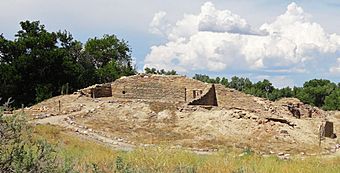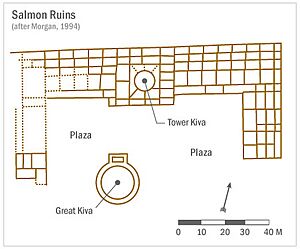Salmon Ruins facts for kids
|
Salmon Ruin
|
|

Salmon Ruins, central room block
|
|
| Nearest city | Farmington, New Mexico |
|---|---|
| Area | 19 acres (7.7 ha) |
| Built | 1089 |
| NRHP reference No. | 70000406 |
Quick facts for kids Significant dates |
|
| Added to NRHP | September 4, 1970 |
Salmon Ruins is an amazing ancient Pueblo site in New Mexico, USA. It was built by people from Chaco Canyon around the year 1090. The original building had about 275 to 300 rooms across three stories. It also featured a special tower kiva and a large great kiva in its main plaza.
Later, local people from the Middle San Juan area used the site, starting in the 1120s. They made many changes to the building. They divided large rooms into smaller ones and added more than 20 small kivas. Ancient Puebloans lived here until the 1280s. Around that time, much of the site was damaged by fire and then left empty.
Salmon Ruins sits on the north bank of the San Juan River. It is west of the modern town of Bloomfield, New Mexico. The site is about 45 miles (72 km) north of Pueblo Bonito in Chaco Canyon.
Archaeologists dug up parts of Salmon Pueblo between 1970 and 1979. Cynthia Irwin-Williams led this important work. They uncovered more than one-third of the ground floor rooms. Over 1.5 million artifacts and samples were found! This helped us learn a lot about the people who lived there.
In 2001, a group called Archaeology Southwest started new research at Salmon Ruins. They helped organize and publish the findings from the earlier digs. This work led to detailed reports and books about the site. They also worked to properly store and care for all the artifacts found.
Building and Living at Salmon Ruins
Scientists used tree-ring dating to learn about the buildings. Tree-ring dates show that the first and second stories were built between 1090 and 1095. The design of Salmon's great house is much like other famous sites. These include Hungo Pavi in Chaco Canyon and Aztec Ruins.
The Chacoan people stopped living at Salmon by 1125. But the site was not empty for long. Other local Puebloan groups used it from 1125 until the 1280s. After 1200, more people lived there, and they traded with other Puebloans. These included people from the Mesa Verde region.
The time at Salmon Pueblo ended sadly in the 1280s. Much of the pueblo was burned on purpose. Some rooms held corn that was destroyed in the fire. In the Tower Kiva, the remains of nearly 20 children and several adults were found. This suggests a tragic event happened when the site was abandoned.
How Salmon Ruins Was Built
The walls of the Salmon great house were made from thin sandstone slabs. This was a common building style in Chaco Canyon. The building is shaped like a rectangle. It stretches about 400 feet (122 meters) from east to west.
The ground floor had 150 rooms. These were grouped into 25 sets, usually with four rooms each. These room sets were likely homes for families. This shows that Salmon Pueblo was a main place where families lived during the Chacoan period.
Two sections of rooms extend south from the main building. They create a large open area called a plaza. This plaza has a great kiva, similar to the one at Aztec Ruins. There is also a special "tower kiva" in the middle of the main room section.
The roofs of the rooms were made with large wooden beams. These beams are called vigas and latillas. This is a style used in many ancient and modern pueblo buildings. The logs for the beams came from large trees like ponderosa pine and Douglas fir. These trees had to be brought from as far as 40 miles (64 km) away.
The great kiva is very large, about 58 feet (18 meters) across. Its roof was held up by four big columns. These columns were built with layers of stone and wood. Salmon Pueblo also had other special rooms. These included rooms for grinding corn and rooms for making stone tools. Some rooms even had features for watching the sky and stars.
See also



